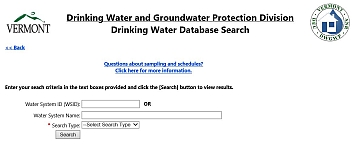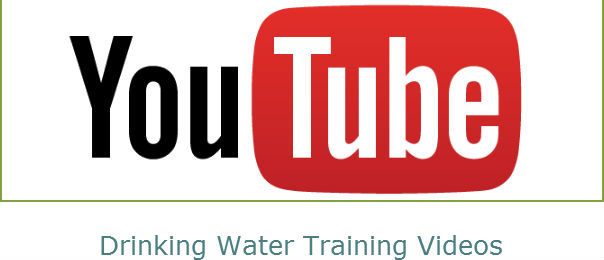Vermont's public water systems are regulated under the federal Lead and Copper Rule (LCR) and the Vermont Water Supply Rule which refers to it. Visit the Vermont Lead and Copper Rule page for more information about current requirements, or to access forms and templates. Learn about the health impacts from lead pipes in water infrastructure by visiting the Vermont Department of Health page.
Under the Lead and Copper Rule Revisions (LCRR), every community and non-transient non-community (NTNC) water system must complete a service line inventory (SLI) no later than October 16, 2024.
- Every community and NTNC water system must inventory all service line connections.
- NTNC and single-building systems must inventory the pipe material connecting the source of water to the building inlet.
- Water systems must develop a lead service line replacement (LSLR) plan if they have at least one:
- Lead service line (LSL);
- Galvanized line requiring replacement; or
- Line of unknown material.
Visit the U.S. Environmental Protection Agency's Lead and Copper Rule Implementation Tools | US EPA page for resources to help water systems implement the LCR including the LCRR.
Lead and Copper Rule Improvements (LCRI)
On November 30, 2023, the U.S. Environmental Protection Agency (EPA) announced further proposed changes to the Lead and Copper Rule called the Lead and Copper Rule Improvements (LCRI). Access VT DEC’s guidance document on the proposed LCRI (Last Updated: March 13, 2024) to learn how this may affect Vermont water systems.
On October 8, 2024, the EPA issued a pre-publication version of the LCRI. Visit the EPA's website about the LCRI for additional details. When the official LCRI is published in the Federal Register, the preceding information will be updated, as well as guidance and information available to the public on this webpage.
On this page:
- Service Line Diagram
- Funding and Assistance Opportunities
- Service Line Inventory Guidance, Templates, and Submissions
- Lead Service Line Replacement Plan Guidance
- Identifying Unknown Service Lines
- Notification of Known or Potential Service Line Containing Lead Guidance
- Leaded Pipes Encountered During Infrastructure Work Guidance
Service Line (SL) Diagram
Funding and Assistance Opportunities
All water systems may develop their SLIs on their own, but there are also assistance opportunities available.
Water Systems with 10 or Fewer Buildings
The Drinking Water and Groundwater Protection Division's (DWGPD) staff are providing free SLI development to very small (10 buildings or fewer) water systems. If a water system is eligible and interested in this assistance, please contact ANR.SLI@vermont.gov.
Contracted Assistance
Assistance for Identifying Unknown Service Lines
DEC intends to use Vermont's Drinking Water State Revolving Fund (DWSRF) Lead Service Line allocation to offer water systems free assistance to identify the materials of unknown service lines. Water systems are eligible for this assistance initiative if they have unknown material service lines in their initial service line inventory. Assistance activities are expected to begin in early 2025 and continue through June 2026.
Requests for assistance are being accepted until January 12, 2025.
Email ANR.SLI@vermont.gov or call Allison Storellicastro at (802) 261-5737 with inquiries about this assistance initiative.
Assistance for Initial SLI Development
Vermont's DWSRF paid for free SLI development assistance for water systems serving 1,000 or fewer people. DEC contracted with MSK Engineers, Otter Creek Engineering, TruePani, and Weston & Sampson to accomplish this work. The contractors worked with water systems to develop and submit the initial SLIs.
Community Water Systems and Non-Profit NTNC Systems
The DWSRF LSL Planning program offers loans for qualified water systems to hire a consultant to develop their SLIs and LSLR Plans or pay for water systems' staff time. All Community water systems and any non-profit NTNC systems are eligible to apply for a loan to complete their service line inventory and lead service line replacement plans and may hire a contractor or utilize a force account agreement.
Visit the Water Investment Division's Applications and Forms page for SLI loan application forms, templates, and policies. The loan amount awarded depends on the water system's number of service connections.
Disbursing Loan Funds to Water Systems (Contractors / Consultants)
-
The contractor or water system submits via ANR Online the final SLI and the LSLR Plan, if necessary. Then, 90% of funds will be authorized.
-
DWGPD staff review the final submission(s), provide comments, and meet with the contractor and/or water system to discuss comments,
-
After comments are satisfactorily addressed and the final submission(s) are approved, the remaining 10% will be disbursed.
Disbursing Loan Funds to Water Systems (Staff Time / Force Account)
Water systems that have identified the materials for 30%, 60%, and 90% of their service addresses may:
-
Send the partially completed draft SLI Excel workbook to ANR.SLI@Vermont.gov.
-
DWGPD staff review the submission, provide comments, and meet with the water system to discuss comments.
-
After comments are satisfactorily addressed and the milestone submission is approved, partial disbursement of funds will be authorized.
Once 100% of the water system's service lines are inventoried:
-
The water system submits via ANR Online the final SLI and the LSLR Plan, if necessary.
-
DWGPD staff review the final submission(s), provide comments, and meet with the water system to discuss comments.
-
After comments are satisfactorily addressed and the final submission(s) are approved, the final disbursement of funds will be authorized.
SLI Guidance, Templates, and Submissions
SLI Guidance
Access the following guidance documents to learn more about how to complete an SLI:
- EPA's Guidance on Developing and Maintaining an SLI (PDF). Last Updated: August 2022
- VT DEC's Service Line Inventory Guidance (PDF). Last Updated: January 27, 2025
- Service Line Inventory Frequently Asked Questions (PDF). Last Updated: June 28, 2024
Watch the DEC's SLI Training Video on YouTube to learn how to complete an SLI. Skip to specific sections of the SLI Training Video by accessing the SLI Training Video Time Stamps Document (PDF). You can also download the SLI Training Presentation Slides (PDF). To attend a live training on how to complete an SLI, visit the Vermont Rural Water Association page for current trainings.
SLI Templates
Community and NTNC water systems must complete their SLI using one of the following templates. Every connection served must be on its own row.
- Multiple Building SLI Template (Excel Workbook). Last Updated: March 10, 2025
- System serves multiple buildings, such as a fire district or municipality.
- Single Building SLI Template (Excel Workbook). Last Updated: February 19, 2025
- System serves a single building with no accessory water use, such as a single-building school or a condominium association all under a single roof.
- Non-Potable SLI Template (Excel Workbook). Last Updated: February 19, 2025
- System has service connections for non-potable water, such as fire protection or other non-drinking purposes. The water system must complete the Non-Potable SLI template for those non-potable connections in addition to the Multiple Building or Single Building SLI template.
Note: when a user begins entering an address, the required cells will auto-fill with orange highlighting until every cell is populated. Users must complete the fields marked as 'required' in the SLIs. The DWGPD will not approve SLIs with incomplete information in the 'required' columns.
SLI Submissions
Water systems must complete and submit SLIs electronically through the SLI Submission Form on ANR Online.
Instructions on how to submit or revise the inventory can be found on the SLI Submission Guidance (PDF).
Making the Service Line Inventory (SLI) Publicly Available
Water systems must make the service line inventory (SLI) publicly available. The method of how a water system makes the SLI available to the public is best determined by the water system. This may be as simple as the water system keeping the inventory in its records and providing a copy upon request or as complex as the EPA’s recommendations in Section 7.2 of the Guidance for Developing and Maintaining a Service Line Inventory (Last Updated: June 2023), which may be better suited for larger systems.
In addition to annual notifications to specifically affected customers that are provided drinking water by lead, galvanized requiring replacement, and unknown service lines, community water systems must also notify all customers in the annual Consumer Confidence Report that the SLI is publicly available.
LSLR Plan Guidance, Template, and Submissions
LSLR Plan Guidance
Requirements for the LSLR Plan were revised by the EPA with the issuance of the LCRI rule. As more information becomes available about LCRI, DEC will share guidance and due dates with applicable water systems that have an approved inventory with at least one (1) lead, galvanized requiring replacement, or unknown material service line. The expected compliance due date for the LCRI-required LSLR Plan is December 2027.
Identifying Unknown Service Lines
During the required records review and visual inspections, some service lines in a water system's initial SLI may be categorized as "unknown material". Water systems must continue to identify the material of these service lines through customer engagement and other strategies designated in the water system's LSLR plan. The Lead & Copper Rule Improvements require water systems to identify all service line materials by November 1, 2034.
Technical Assistance from DEC
DEC is contracting with engineering consultants to assist Vermont water systems with identifying unknown service line materials. Contractors will be tasked with canvassing customers, visual inspections of customer-owned service lines, water quality sampling, and revising water system's SLIs.
Encountering Leaded Pipes during Infrastructure Work
When lead service lines, galvanized requiring replacement service lines, and lead connectors (a.k.a. goosenecks and pigtails) are encountered during infrastructure work, access the Leaded Pipes Encountered During Infrastructure Work Guidance Document (PDF). This guidance document includes instructions, notification and certification documents, and an outline of the actions permittees and water systems must follow when leaded pipes are encountered.
Notification of Known or Potential SL Containing Lead Guidance
The federal Lead and Copper Rule (Revisions) (40 CFR 141, Subpart I) requires all water systems with lead, galvanized requiring replacement (GRR), or lead status unknown service lines in their inventory to inform all persons served by the water system at the service connection with a lead, GRR, or lead status unknown service line.
If a water system’s initial service line inventory includes a lead, galvanized requiring replacement, or unknown material service line, then the water system must notify affected customers by November 15, 2024 if the initial Service Line Inventory was submitted on October 16, 2024. For systems that submit the initial Service Line Inventory late, then the water system must notify affected customers no later than 30 days after the inventory's submission date.
Water systems should certify to the Vermont Department of Environmental Conservation (VT DEC) no later than 10 days after delivery of the notification is delivered. In accordance with the Lead and Copper Rule Revisions (LCRR), water systems must provide the certification to VT DEC by July 1, 2025.
As new customers connect or start service with the water system, water systems must also provide notice at time-of-service initiation.
Access Guidance and Instructions for Notification of Known or Potential Service Line Containing Lead (PDF) (Last Updated: October 25, 2024)
Access Template for Users Affected by Galvanized Requiring Replacement (GRR) Service Lines (PDF) (Last Updated: November 14, 2024)
Access Template for Users Affected by Known Lead Service Lines (PDF) (Last Updated: November 14, 2024)
Access Template for Users Affected by Unknown Material Service Lines (PDF) (Last Updated: November 14, 2024)
The Service Line Notification Delivery Certification form may be submitted through ANR Online (Last Updated: November 20, 2024) or by emailing, mailing, or faxing the Service Line Notification Delivery Certification (PDF) (Last Updated: June 7, 2024) and notification documents to VT DEC Drinking Water and Groundwater Protection Division’s Infrastructure Sustainability Section.
Last Updated on March 10, 2025


